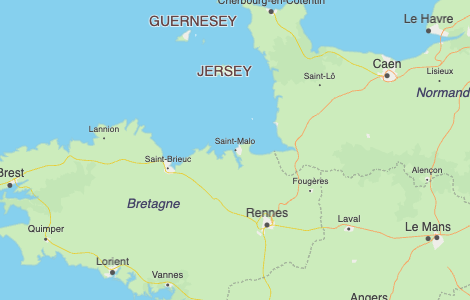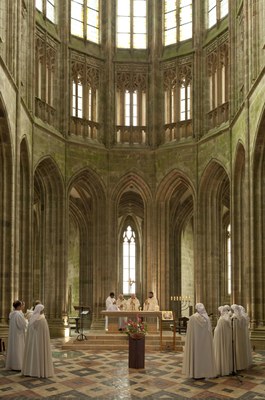1000 years of pilgrimage: Mont-St-Michel and the modern pilgrim—Purposeful Travel
The Archangel loved heights. Standing on the summit of the tower that crowned his church, wings upspread, sword uplifted, the devil crawling beneath, and the cock, symbol of eternal vigilance, perched on his mailed foot, Saint Michael held a place of his own in heaven and on earth… So soldiers, nobles, and monarchs went on pilgrimage to his shrine; so the common people followed, and still follow, like ourselves.
Henry Adams, 1913.

“SACRÉE BRETAGNE”, parcours-photo dans le parc du sanctuaire de Sainte-Anne d’Auray du 25 mai au 4 novembre 2019. Photo: Pelerins dans la baie du Mont-Saint-Michel”
Who hasn’t visited, or dreamt of visiting, Mont-St-Michel?
One of the most iconic and photographed places in France, the steeple of its ancient stone church rises majestically into the clouds, whilst its feet sit firmly in the shifting sands and resist the relentless tides. Popular with tourists all year round and overrun in the warm summer months, would it surprise you to know that this tiny rock has been a magnet for pilgrims since the Middle Ages? Since the 12th century, the abbey has been one of the most visited sites for pilgrims in France and held court for kings and queens. Today, whether your journey to the island be in search of beauty, history, or religion, take note of the words of Henry Adams:
To feel the art of Mont-Saint-Michel we have got to become pilgrims again
Mont-St-Michel: the history of the island

A church has stood on the granite rock, which juts out into the English Channel, since 708. According to legend, the bishop Aubert was visited in his dreams by the archangel Michael three times, who demanded a church be built in his honour (the bishop was an unbeliever until he apparently awoke with a hold in his head where the insistent angel had poked him).
Why Saint Michael?
It was once believed the mount was the location of the fiery duel between the archangel and the dragon, mentioned in the Book of Revelations. Or we can believe French author Guy Maupassant, who wrote a story recounted by a peasant in which Saint Michael settled himself on the island, surrounded himself with dangerous quicksand to deter the evil Satan, and after a number of battles chased the devil to the very top of the isle where he was unceremoniously kicked far onto the mainland.
Around the time William the Conqueror was settling into England, Benedictine monks were in possession of the rock, and within several hundred years an abbey had been built at its very peak. The cloisters, built in the 13th century and famed for their Gothic beauty all over Europe, sit high above the walls and are now a tranquil garden where the fresh sea breezes provide relief on a summer evening.
The Benedictine monks produced a large number of beautifully illustrated manuscripts and books on the island, which gave Mont-Saint-Michel the name “The City of Books”.
Medieval pilgrims at Mont-St-Michel
It’s a dangerous pilgrimage – the tides surrounding the rocky outcrop are strong and fast, and many have drowned. The tides can vary by as much as 15 metres depending on the time of year. In the Middle Ages, the island (it’s only considered an island when it’s completely surrounded by the tides) was much further out in the bay, and pilgrims had to very quickly cross seven kilometres of quicksand, mud, and water during low tide in order to reach the fortified town. It’s no wonder the journey was referred to as “peril of the sea” in medieval times. In 1318, 30 pilgrims died when trying to reach Mont-Saint-Michel, and even now, rescues of tourists and pilgrims remain common.
St Michael’s miracles
In the 15th century one of many miracles occurred; a pregnant woman, in labour, was trapped in the rising waters and desperately called out to the Archangel and the Virgin Mary for help. The heavens opened, a sleeve appeared to hold onto, and the woman was miraculously kept clear of the fast-moving tide. According to the legend, both mother and child were saved.
Miquelots
A medieval pilgrimage was long and arduous. Pilgrims who travelled to Mont-St-Michel were called miquelots, and we can today read their joy at reaching their destination. A young monk, William Saint-Pair, who first saw Mont-St-Michel in the 12th century, described the atmosphere:
The day was clear, without much wind.
The maidens and the varlets
Each of them said verse or song;
Even the old people go singing,
All have a look of joy.
For the great joy they feel.
Even in the woods sing all
The little birds, big and small.
Horns and trumpets and shepherd’s pipes
And flutes and pipes of reed
Sound so that the mountains
Echo to them, and the plains.
About the Mount, in the leafy wood,
The workmen have tents set up;
Streets have made along the roads.
Plenty there was of divers wines,
Bread and pasties, fruit and fish,
Birds, cakes, venison,
Everywhere there was for sale.
Enough he had who has the means to pay.
From sanctuary to slammer
After a starring role in the Hundred Years’ War in which the strong defensive walls kept English invaders from breaching the rock, the abbey buildings gradually crumbled and fell into disrepair. During the French Revolution, the dungeons of the abbey were filled with hundreds of priests and became known as the “Bastille of the Sea”. Napoléon later thought to use it as a prison. Thankfully, the French government took ownership of the historic buildings and an enormous restoration project was begun in the late 19th century.

The chants of Benedictine monks once again soared to the ceiling of the Gothic church in 1966, when they returned to the Abbey.
A modern-day pilgrim
In many ways, little has changed on Mont-St-Michel over the past thousand years. Whether you’re a pilgrim or a tourist, the sight of the castle-like fortress, silhouetted against the blue skies of the bay, is awe-inspiring. The narrow, cobbled streets of the island town have fed and accommodated visitors regardless of their religion or race since the first stone was laid in the 8th century.
The Grand Rue has always been the hub of the town, with its hotels, restaurants and tacky souvenir shops. So in a way, when we visit this granite island, we are all pilgrims.
Here’s how you can be a modern pilgrim:
- Since 2001, the religious community of Fraternités de Jérusalem has occupied the abbey and offer spiritual retreats.
- Take off your shoes and view the island from the sand, like a medieval pilgrim (be aware of the tides). Or better still, walk across the Bay with a local guide, to really follow in the footsteps of the miquelots.
- Visit the Scriptorial, a museum in the nearby town of Avranches, which houses medieval manuscripts from the Abbey
- There are many walks along ancient pilgrim routes which are very popular at the moment – take a day, a week, or even months, and make a modern-day pilgrimage, either starting or finishing at Mont-St-Michel.
A pilgrimage is not always about religion – it can be about self-discovery, reflection, exploration, a journey through time.
Luckily for us, the journey to Mont-St-Michel now is less fraught with danger than for the miquelots. When you visit Mont-St-Michel, try to see it through the eyes of medieval pilgrims.
Have you visited Mont-St-Michel? Where would you go for your own spiritual journey? Share your thoughts and experiences below.
Image credits:
1. Pilgrims – @yvon_boelle Instagram
2. Map via brittanytourism.com
3. Abbaye Mont-Saint-Michel.com
4. Wikimapia via Twitter






